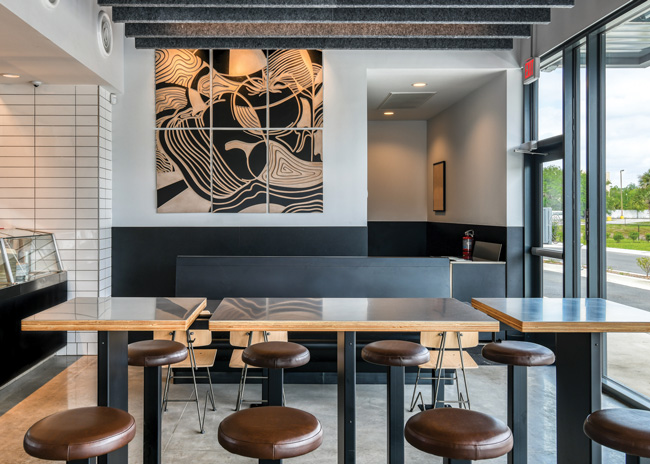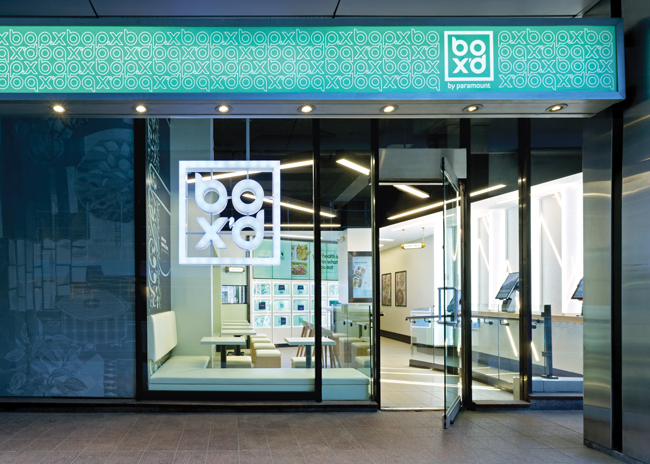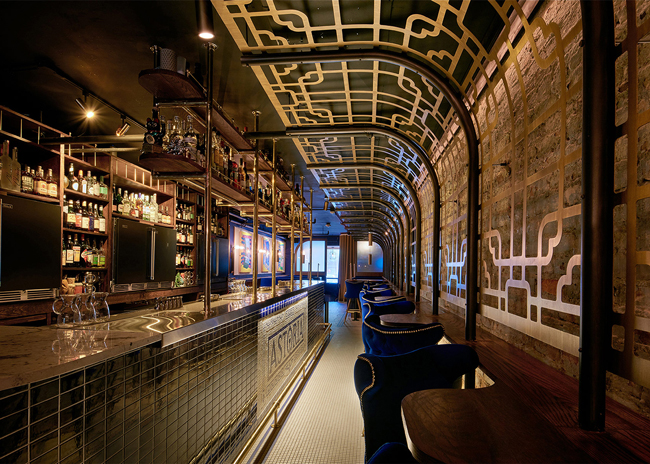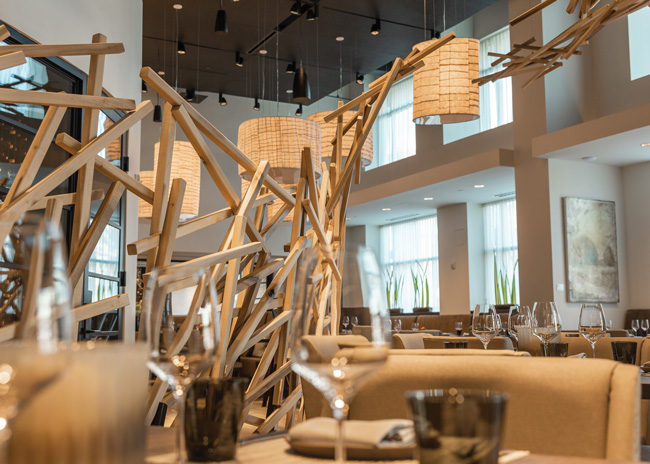 Farmers Restaurant Group takes sustainable building practices very seriously including using sustainable materials, diverting construction waste and more. Images courtesy of FarmersSustainable construction practices are not yet mainstream in the restaurant industry, but some companies are looking to pave the way. “It’s happening more but it’s definitely not prevalent,” says Michael Oshman, CEO and founder, Green Restaurant Association, Boston, Mass.
Farmers Restaurant Group takes sustainable building practices very seriously including using sustainable materials, diverting construction waste and more. Images courtesy of FarmersSustainable construction practices are not yet mainstream in the restaurant industry, but some companies are looking to pave the way. “It’s happening more but it’s definitely not prevalent,” says Michael Oshman, CEO and founder, Green Restaurant Association, Boston, Mass.
There are simple switches most restaurants have been making, of course, such as moving to compact fluorescent and LED lighting and switching to Energy Star-rated appliances. Some restaurants have incorporated their own gardens, which is a positive move, and can sometimes encourage restaurants to think about next steps, Oshman points out.
But some operators are being more innovative and thinking broadly about their approach to sustainable construction.
Sustainable Materials
Leslie Silverglide is the CEO and co-founder of Mixt, a fast-casual restaurant chain with 19 units in Arizona, California and Texas.
Each Mixt location is built following green principles. Paint is recycled; plywood is formaldehyde-free. At a second-generation location, the Mixt building team tries to keep as much of the existing building as possible.
One of the most important factors to Silverglide is building and designing restaurants that endure. “Re-doing the interior of a restaurant every five years creates a tremendous amount of waste, with a lot going to landfill. So, we focus on how we can build our restaurants with a long-term perspective.” Silverglide hopes each of her restaurants will last for 15 years without being renovated. Mixt’s first two locations opened in 2006 and 2007 and have only been repainted, using zero-VOC paint.
Silverglide builds for durability, using top-of-the-line materials. Otherwise, she says, you end up replacing them. This includes items like real stone (for countertops); real wood; bamboo and FSC-council certified wood. Sometimes, she says, “it can be better to buy something less sustainable but that would last through renovations.”
Silverglide likes to steer clear of medium density fiber (MDF) engineered wood because its off gassing can cause problems like headaches, eye irritation
and even cancer for those working with the material over time. She double-checks any product that claims to be made with “real hardwood” to make sure it is authentic. Unfortunately, it’s not possible to completely avoid MDF, Silverglide points out, in which case she looks for formaldehyde-free plywood, which she’ll sometimes use in a subfloor if there are no other viable alternatives.
 Farmers Restaurant Group takes sustainable building practices very seriously including using sustainable materials, diverting construction waste and more. Images courtesy of FarmersUtilizing natural materials like stone and wood allows Silverglide to achieve a timeless design aesthetic and helps her avoid anything trendy that will appear dated sooner. For more unusual features, she says, “we let our fresh ingredients bring the majority of life and color to restaurants. For example, we have a wall of lettuces behind our service line with the different varietals of lettuce we offer.”
Farmers Restaurant Group takes sustainable building practices very seriously including using sustainable materials, diverting construction waste and more. Images courtesy of FarmersUtilizing natural materials like stone and wood allows Silverglide to achieve a timeless design aesthetic and helps her avoid anything trendy that will appear dated sooner. For more unusual features, she says, “we let our fresh ingredients bring the majority of life and color to restaurants. For example, we have a wall of lettuces behind our service line with the different varietals of lettuce we offer.”
The cost of building these more sustainable restaurants is what usually holds operators back. Immediate costs are higher, Silverglide says, but once you spread those costs out over 15 or more years, compared to a restaurant that renovates every five to seven, “it ends up being beneficial.”
Farmers Restaurant Group of McLean, Va., which has seven restaurants on the East Coast, also looks for durable materials and likes to use bamboo, which is fast-growing so it's more easily replaceable than other items. But that’s only one of many variables, says Lara J. Hardcastle, Farmers' senior vice president. She also looks for low- or zero-VOC products; and looks to source materials locally.
When Farmers builds a new restaurant, it tries to divert at least 90% of its demo and construction waste from the landfill and recycles materials such as wood, concrete metals, plastics, glass and cardboard. This is taken by waste recovery facilities who separate it and send it on to its next use. Founding Farmers receives a report of what was diverted, and where.
Farmers visits stone yards and looks at scraps and remnants, especially if it’s just looking for something small like a bar top.
Renewable Energy
 Chipotle opened 10 all-electric restaurants in 2023 and plans more for 2024. Committed to serving “food with integrity,” Chipotle last year opened 10 all-electric restaurants and has more planned for 2024.
Chipotle opened 10 all-electric restaurants in 2023 and plans more for 2024. Committed to serving “food with integrity,” Chipotle last year opened 10 all-electric restaurants and has more planned for 2024.
These locations use 100% renewable energy from wind power and solar. This is all part of Chipotle’s plan to cut its greenhouse gas emissions in half by 2030 when stacked against 2019.
Solar panels provide a portion of the power for these restaurants and the chain has implemented energy management systems to control what locations are using. All equipment in these restaurants is electric, heat pumps warm and cool the spaces, and the exhaust hoods are more efficient. Chipotle has also committed to changing the setpoints of its HVAC units seasonally.
A year ago, Wendy’s announced that it was aiming to reduce greenhouse gas emissions by 47% by 2030 as compared to 2019. In 2022, Wendy’s joined the Duke Energy Florida’s Clean Energy Connection pilot program, which now supplies 22 company-owned restaurants with solar energy. This is part of Wendy’s goal to develop a renewable electricity procurement strategy across its system.
“We have set ambitious goals for cutting our greenhouse gas emissions and are exploring new initiatives that can help meet and exceed our goals,” says Liliana Esposito, chief corporate affairs and sustainability officer for Wendy's. “This includes considering everything from on-site generation to utility procurement options for retail and regulated markets to the procurement of renewable energy certificates.” By 2025, Wendy’s hopes to have 35 restaurants with 100% renewable energy, sourcing 6,363 kilowatts of power.
There are many benefits to this initiative including long-term efficiencies and cost savings. But there’s another side to doing the right thing because customers are increasingly aware of climate change and of what corporations are doing to combat it. Initiatives like solar power “will contribute to the long-term success of our business and brand,” Esposito notes. The only downside she points to is that renewable energy demand exceeds supply in many markets and renewable energy development takes time.
Minimizing Energy
Thinking ahead to lowering energy usage should happen in the construction phase of a restaurant. Silverglide aims to have as much natural light in Mixt locations as she can, with large windows and skylights. “It’s about utilizing windows and looking for spaces with large window lines,” she says. Natural light reduces the need for electric lighting and numerous studies have shown it has a positive effect on health and well-being.
It’s also important to make sure lighting is controlled for different times of the day and programed correctly, Silverglide points out.
Windows are important, says Hardcastle, and most Farmers restaurants have a lot. The restaurant group uses Solarban low-e glass, which helps keep outside air out and inside air in. It also reduces light transmittance, keeping AC costs down. Sometimes restaurants add high-performance solar control window film, typically where there’s direct or intensive sun on glass, in order to choose their own light and UV transmittance, “but you have to think about the winter when you might want some heat to come through,” says Hardcastle.
In its restaurants, Farmers also places aerators on faucets, has low-flow toilets, and even the restaurants’ hoods have variable speed drives so they’re not running on full all day. Farmers Restaurant Group also installs real-time energy monitoring “so we can track usage and can more granularly find what is consuming the most,” Hardcastle explains.
Farmers has also built on-site aerobic digesters in two restaurants where it can’t compost. It places these digesters — which are know as the Pigs — as near to the dish room as possible, where the scraps are generated.
Reclaimed and Recycled
In the search for sustainability, Mixt is always testing out new things, such as tabletops made from recycled milk jugs and different types of wood such as palm wood and even resin panels.
Farmers Restaurant Group, is “always trying and exploring different products because things are always coming out,” says Hardcastle. “We use some reclaimed materials, we try to use local and sustainably harvested wood.” And each restaurant tends to be a composite, using some traditional materials and as many better materials choices as possible. “We always want to stand out and be unique, and that drives the search for new products that align with our principles,” she adds.
The company tends to work with educated vendors, like millworkers who know where to find reclaimed materials or know of barns being dismantled where the wood is going up for sale. “Relationships are everything,” Hardcastle says. “We follow the LEED standard and try to work with people within 500 miles. We’re not able to do it entirely but we can do it a lot.”
Farmers most frequently uses reclaimed wood in wall cladding, often in low walls or background accent walls, in ceilings or ceiling beams, or even in an elevator. “We use it in places where it’s a more decorative finish,” Hardcastle says. “It is very character grade so it leans a little more rustic, though in some restaurants we’re looking for a more elevated or refined finish so it might not be right.”
In the Founding Farmers King of Prussia, Pa., location, the restaurant group repurposed a huge, beautiful mantle from a car dealership. In another location, the bar front is made from reclaimed shoe crates. Farmers Restaurant Group works with companies that specialize in these types of products, though Hardcastle explains that “sometimes getting enough of something can be tricky.”
The cost of using reclaimed materials isn’t necessarily cheap, says Hardcastle, especially since wood often needs to be tested and remediated for lead.
“We’re always evaluating through the lens of “is this sustainable?” says Hardcastle. “Are we making decisions that are good and long-term. We keep innovating and learning and trying.”



